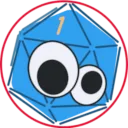I've been refining my numerous Commander/EDH decks and pondering how well they would fare against one another or against the decks other people might build. Online groups and forums casually toss off numbers for their deck power levels, but there isn't any cohesion. A deck that competes well with one group might completely flounder elsewhere. A good deck with a bad player will likely lose against a less-optimal deck piloted by someone more experienced and familiar with how all the cards work together.
What is Commander?
In short, Commander is a casual Magic: The Gathering format created ages ago as "Elder Dragon Highlander," so the term EDH is often used even now. Originally, a deck would include 100 cards led by an Elder Dragon, and it was a singleton format. In other words, aside from basic lands, there can be only one copy of any other card. It was intended as a kitchen-table casual fun format with four players in a game, as opposed to the typical competitive 1 vs. 1 60-card tournament formats.
Nowadays, almost any Legendary creature and a few other specific cards can be selected as a commander. There is also a list of cards banned for being too powerful or just not at all fun to face. Otherwise, deck construction remains the same: 100 cards exactly, and each card must be unique except for basic lands and a few cards which specifically say any number may be included in a deck. Read more here.
What are Power Levels?
The game encourages creative deck design with a variety of tactics. There has always been a sort of rock-paper-scissors debate between aggro, combo, and control decks. There are also a few player archetypes that have emerged to loosely categorize players. Combine these factors with decades of cards to choose from, and you can see how hard it is to categorize decks. Nonetheless, here is my best effort. We're stuck with levels 1-10, but there is a lot of murkiness where one starts and another ends.
Power Level 1
This deck meets the bare minimum criteria to be a legal Commander deck: a legendary creature card, enough basic lands to play, and the rest of the cards meet the color identity requirements set by the commander. This is probably the first deck new players build from their collections.
Power Level 2
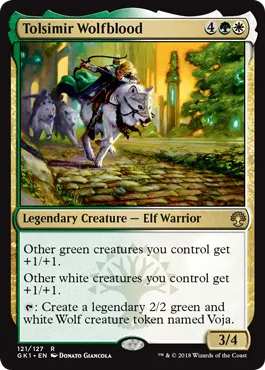
There are many Legendary creatures that don't really work as generals/commanders, so now we're looking at the bare minimum for a functional deck where the commander does something beneficial for the rest of the 99, and vice-versa.
I think my first deck brews fell here. Tolsimir Wolfblood (pictured) offers more than just access to green ramp, white defense, and elf tribal opportunities. He also makes any other green or white creature better, and anything both green and white is even more better. However, I didn't know enough about how to make the other 99 cards work together in order to play at a good pace and achieve a good win condition.
Note to self: revisit Selesnya token deck ideas...
Power Level 3
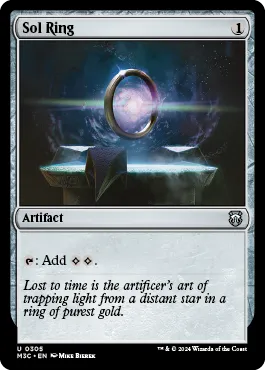
I would argue the early Commander sets released when Wizards of the Coast first started to support the format fall here. These decks add some good cards, but there is still no real cohesion. Maybe there are too many ideas competing for the resources and time a game allows. This is capable of playing and winning, but not quickly.
Sol Ring (pictured) is a Commander staple which has been included in even the least-competitive Commander deck releases. If you don't have it and a few other mana rocks or mana dorks in your deck, you probably aren't tier 3.
Oh, right. Slang. A "mana rock" is an artifact that can tap for mana, and a "mana dork" is a creature that can tap for mana. Your deck needs one, the other, or both. Lands don't produce enough resources on their own when played at the usual rate of one per turn, especially if you're playing lands that enter tapped.
Power Level 4
I think this is where the idea of a mana curve starts to enter the picture. How quickly can you build a mana base, and how efficiently can you spend your mana to build a board state of spells and creatures? This is where we start to see an idea of deckbuilding as a science, and cards are selected or rejected based on a deeper idea of what works together.
Power Level 5
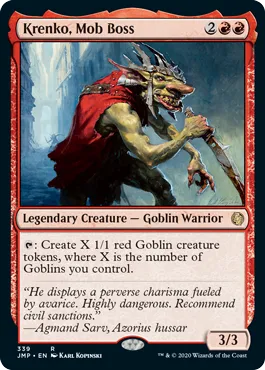
Most modern preconstructed decks fit this power level, with more cohesive strategies and a definite plan for both playing and winning. There is room for improvement, but the deck plays like a deck should right out of the box.
I think this is also where a more experienced deckbuilder's attempts may fall when initially testing a new idea. Which ideas work, and which ideas are actually fun to play?
A tribal deck (Nope, not using the politically-corrected term "typal," ever) like a Krenko, Mob Boss (pictured) goblin deck will have a variety of cards reinforcing one another. A storm deck will have a plan to draw and cast spells to build a storm count before unleashing a powerful spell. A combo deck will have a way to win by going infinite, even if it isn't a guaranteed outcome.
Power Level 6
At this stage, decks should start to include not only a plan to play and win, but also ways to interact with other players. There will be more cards to remove artifacts, creatures, enchantments, and even lands from black and red decks. Blue will definitely be starting to play counterspells. Expect fog effects and other damage prevention from green and white. This is where the game really starts to shift from deck versus deck to players making political choices around the table and playing against one another as well.
Power Level 7
This is often the generic answer to, "how good is your deck?" It implies a cohesive deck with a game plan to win and ways to interact with the board without anything being overpowered. There will be ways to ramp mana, tutor for specific cards, and stop threats from other players. If you have refined a homebrew deck or modified a preconstructed commander deck, it's probably a 7.
Power Level 8
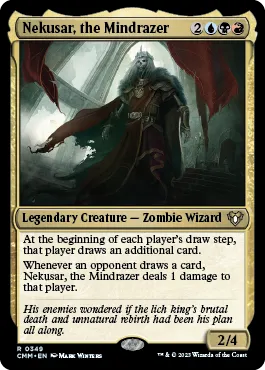
This category is probably the most difficult for me to define. It's a deck with some high-dollar cards and powerful interactions, but not really at the competitive cEDH level. I'd argue my upgraded Nekusar, the Mindrazer homebrew might fit here based on the following criteria, although it does need testing at a real table first.
You might be power level 8 if you have:
- Fast mana cards like Dark Ritual or Seething Song
- A willingness to treat your life points as a resource, especially as an added cost to cast spells
- Expensive mana rocks like Chrome Mox or Mana Crypt
- Several tutor cards or related effects
- Dual lands and shock lands
- Board wipes and other major interaction effects
Power Level 9
This is the start of serious competitive EDH deckbuilding. If you're a Spike with deep pockets, this is where you're aiming if you aren't here already. These decks leverage ramp, combos, creature abilities, and more for fast wins. This is either designed for a competitive scene, or a brew by that guy who just wants to show off at game night.
Expect to lose against this level by turn 4 or 5 unless your deck can really interact. This is no longer kitchen table magic.
Power Level 10
There are good decks, and then there are top-tier competitive EDH decks. These are the most versatile, consistent, effective, fast, and powerful decks out there.
Was that helpful, or clear as mud? Does this seem like an accurate representation of power levels, or am I way off base? Comments and criticism are welcome as always.
